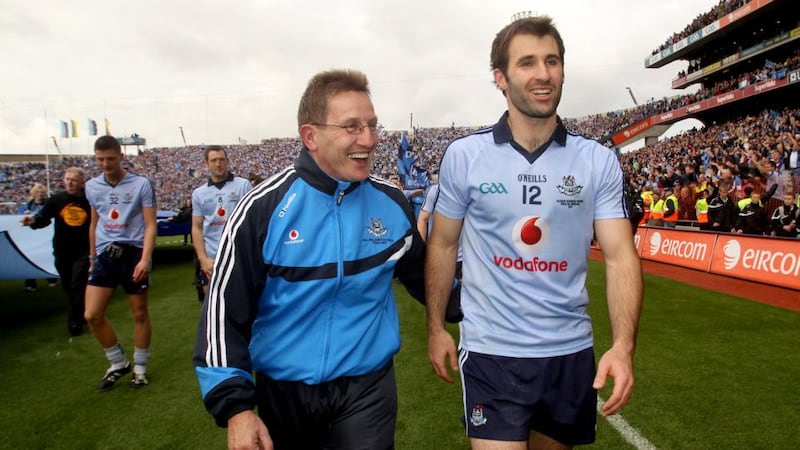They came to look for disease. It was the 1970s in Scotstown, Co Monaghan. The van arrived at Niall Moyna’s school, and the children were all X-rayed to check for tuberculosis. Three weeks later, Moyna’s parents received an urgent letter. Their son had an enlarged heart that could lead to serious health complications.
Moyna was taken to St Vincent's Hospital in Dublin to meet Dr Richard Mulcahy, a pioneering heart specialist. Moyna was hooked up to various machines, including an exercise bike. The doctors found that he was very physically fit, which was put down to his involvement in sport, and told him that his health was not at risk.
“A switch went off in my head,” Moyna says. “I thought this was fascinating. It reinvigorated my interest in science. I bought books about the human body, particularly how I could improve myself as an athlete. And I knew I wanted to pursue a career in sports and science.”

Niall Moyna is now a professor at the School of Health and Human Performance and a member of the Centre for Preventive Medicine, both at Dublin City University (DCU). He's also a major force in sport coaching.
One of Moyna’s projects mapped the relationship between high-intensity training and the body’s response. The startling results of this could change the way we approach both amateur and professional sports, particularly GAA, soccer, rugby and hockey. “We compared continuous running to high-energy intermittent running,” Moyna says. “We found that high-intensity intermittent running was much more effective than continuous running.”
What does this mean in practice, and what difference will it make? “Athletes could reduce their amount of training by 90 per cent by focusing on high-intensity training. It’s a model I have used as a coach with DCU and with Dublin’s Gaelic football team. It replicates the nature of team sports, where you don’t run continuously, but stop and start.”
Moyna believes the lessons learned through sports science can apply to school sports, and he is a passionate advocate of physical education in schools. “Sometimes parents want their children to forget about sports during the very busy Leaving Cert year. This is a mistake. Exercise has a beneficial effect on the brain. It increases the number of neurotransmitters, nerve cell growth and connections between different parts of the brain. This increases information processing, storage and retrieval.”
Competitive sport, worthwhile in its own right, also helps people to develop discipline, leadership and teamwork skills; figure out how to handle adversity; and learn humility and time management, Moyna says. “Being involved in sport helps build up all these transferable skills, which are valuable for life and work. I wish parents would understand this. Today’s young people are leaving school more unfit and unhealthy than any previous generation.”
So what’s going wrong? “There are often mixed messages, particularly in the nutrition field, and this can be confusing,” Moyna says. He is particularly critical of sports drinks and says that young people are being encouraged to consume them by commercial interests. “It is ludicrous for children to take sports drinks. In the average championship game, the ball is in play for less than 32 minutes. Even a child exercising at lower intensity has more than enough fuel in his or her muscles for this.
“I hate the term ‘diet’ because it suggests that you do something different for a period of time. What is important for everybody is a healthy eating pattern and a well-balanced diet, over time, based on the food pyramid. Eat more carbohydrates than fats. I was never on a strange or fad diet, and it never compromised me.”
Over the past decade Moyna has worked with expanding research teams, including nutritionists. “Science is becoming more interdisciplinary. Athletes can wear GPS systems, have heart and breath monitors and carry out finger-prick blood samples. Someone has to make sense of the data, before, during and after the game. Technology specialists and engineers develop the hardware and I apply the science, while of course a computer scientist is developing an algorithm to help me make sense of the information. We’re making connections and gradually revealing a broader context that makes science so much more exciting. Working together, we can achieve tremendous results.”
'Be adaptable and flexible. Forget the old drills': a career in coaching
Niall Moyna knows about leading teams to victory. The professor of health and human performance joined Dublin City University when it had no reputation for sporting prowess. Slowly, DCU has come to dominate college athletics, with Moyna managing teams to three Sigerson Cups, two O’Byrne Cups and a Ryan Cup.
DCU and Dublin's GAA teams have become intertwined. There's no doubt that DCU played a big role in bringing Dublin to the top, says Moyna. "By 2011, almost half the Dublin panel were DCU graduates, while the team were also training in DCU with coach Mickey Whelan, who was studying here."
Moyna himself has played a crucial role in Dublin’s GAA team, serving as a selector and a key part of the backroom team. He’s never been afraid to speak his mind: Earlier this year, he warned that young Dublin players are not getting enough recovery time, leading to an increased risk of kidney failure, muscle damage and long-term health problems.
He says that anyone who wants to succeed in a team-based sport should be “adaptable and flexible. Forget the old models of drills in a straight line. Be prepared to change tactics during a game. This is not how things were done in the past, but coaching science, a huge new emerging field, has changed the face of sport.”
Embrace chaos, he advises. “Children should be involved at a young age in small-sided games. With six-year-olds in the game, it becomes chaotic. This chaos is actually helping them to solve problems; it will reduce over time. What you’re left with is more adaptable players.”















